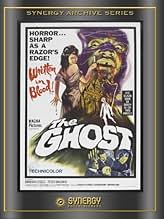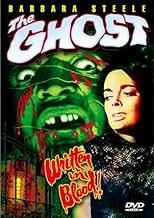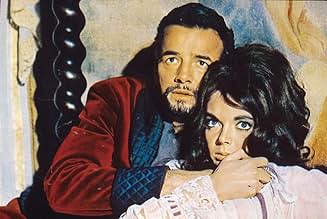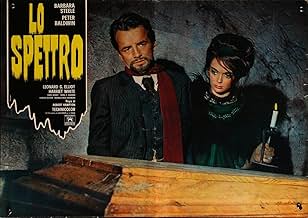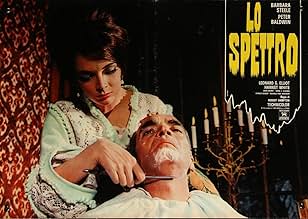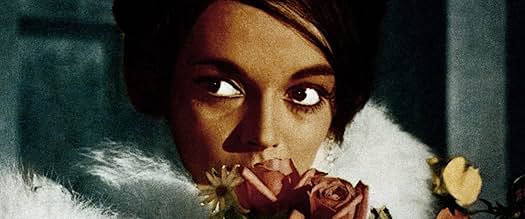VALUTAZIONE IMDb
6,1/10
1553
LA TUA VALUTAZIONE
Aggiungi una trama nella tua linguaA woman and her lover murder her doctor husband, but when strange things start happening, they wonder if they really killed him, or if he has come back from the dead to haunt them.A woman and her lover murder her doctor husband, but when strange things start happening, they wonder if they really killed him, or if he has come back from the dead to haunt them.A woman and her lover murder her doctor husband, but when strange things start happening, they wonder if they really killed him, or if he has come back from the dead to haunt them.
- Regia
- Sceneggiatura
- Star
Elio Jotta
- Dr. John Hichcock
- (as Leonard G. Elliot)
Harriet Medin
- Catherine Wood - Housekeeper
- (as Harriet White)
Carlo Kechler
- Police Superintendent
- (as Charles Kechler)
Umberto Raho
- Canon Owens
- (as Raoul H. Newman)
Recensioni in evidenza
This film perhaps holds up better than the first Dr. Hitchcock film and can be seen with or without that film. It stands on its own. A good film for people to be introduced to director Freda's work with. It gets better with repeated viewings and the music score is very good. This is not, just as none of his films are, a supernatural movie. So just know that going in. The film still has a good Gothic feel to it. Sadly there is no really good DVD release version of the film. There is a key and very graphic murder scene that is either cut down or cut completely out of several versions available. Without that being intact the impact of the later part of the film is really reduced. Think about Psycho if you basically cut out the shower scene. Not that this is in Psycho's league but this scene I'm talking about really makes this film work. It would be nice if Freda's films got a box set release of proper versions of his film. He started Mario Bava's career and Argento says Freda had more of an influence on him than Bava was. For now you have to really look hard and watch pretty lousy versions of his films to try to discover him as a director. It's worth the effort but would be nice for him to get some decent releases.
Riccardo Freda, an Italian director of skill who directed many Sword and Sandal films of the 60's as well as horror greats like I Vampiri, does a very serviceable job directing this thoughtful, mood-laden sequel of sorts to his earlier effort The Horrible Doctor Hitchcok. One does not need to have seen that earlier effort to follow what goes on here as they are really entities unto themselves with the same characters just going through different circumstances and having different motivations. In this film Dr. Hitchcock(living in Scotland - very implausible given the Mediterranean looks of most of the cast) is bound in a wheelchair and has nothing but sickly pity for himself as he wishes to die. Helping him remain alive is a local doctor giving him some sort of concoction to live and, of course, no love triangle would be complete without the love object of the other two sides - sultry, hypnotic breathless Barbara Steele - the 60's queen of the horror film - particularly the Gothic horror film. Steele is not a great actress by any stretch. She is lovely to look at and has the most impressive pair of - yes, I know where I could go here but really I intended to say eyes the entire time. Freda creates a slowly building tension between the central characters and the story is nothing exceptional in terms of creativity. You have seen this story before in various adaptations. Freda does; however, have a flair with the camera lens, and I was really surprised at how well he, the actors, and the story all combined to make an interesting film experience. The rest of the cast is all serviceable with Elio Jotta as Dr. Hitchcock being particularly effective and Harriet Medin(who was in the previous Hitchcock film also as a maid) doing a nice, creepy job as Catherine the housemaid. There are some very powerfully shot scenes: the tomb scene is genuinely eerie and the final denouement is quite good. Loads of atmosphere make this one of the best of its kind.
I remember getting my drivers' license. It allowed me to travel to towns a few miles from mine and see movies (only one was shown at a time in those days) at small local theaters. In the sixties we had Vincent Price, Peter Lorre, Sebastian Cabot, and others entertaining us with lightweight, scary little films. Many were based loosely on the works of Poe. Though I never saw this until a few minutes ago, it fits in with that genre. It has wonderful atmosphere. The heroine is not blameless, but has a case for murdering the old meany. Of course, she's going to pay a price, as is her doctor lover, when the old guy comes back to haunt her. There's a little Rebecca and Gaslight here, but it all works nicely to a satisfying conclusion. He who laughs last, of course. The performances are good and the atmosphere of the castle and its bleak goings on is a lot of fun. There is an intensity at work here that build, till people become paranoid and suspicious. See this. It's not a bad ghost story.
This highly-regarded example of the Italian Gothic Horror style had eluded me until now; even so, having caught up with it at long last, I still wasn't done with the 'Curse Of THE GHOST': the Retromedia DVD proved faulty, with a glitch around the one-hour mark (where the image skipped and the audio dropped out) and then experienced complete freezing after 88 minutes - so much so that I had to finish the film off on another player! This was after a public domain copy I rented from Hollywood when I was there in late 2005 (which, on a hunch, I decided to check before watching) reverted to the Main Menu midway through the climax!!
Anyway, the film itself is undeniably a highlight of the genre and one of Freda's best (which he made in just 12 days): a follow-up, not a sequel, to his previous collaboration with star Barbara Steele - THE HORRIBLE DR. HICHCOCK (1962) - despite the re-use of that notorious character's surname. In the earlier film, too, Steele had been overshadowed by a delightfully manic turn from Robert Flemyng but, here, she lives up to her iconic status as the Queen Of Gothic Horror: few actresses have managed to replicate her sensual mix of wickedness and vulnerability; as for the actor playing Hichcock this time around, who looks a bit like Howard Vernon, he's not too bad - if no match, ultimately, for Flemyng.
Like I said with respect to Hammer's FEAR IN THE NIGHT (1972), the plot twists aren't very original - but they make for a great ride regardless; besides, one could just soak in the colorful visuals (even if the print involved features a lot of wear and tear!). Incidentally, the film is rather gory for its time (witness the 'ghost' exhibiting its decaying flesh and the brutal razor murder, with its wonderful device of having blood dripping across the camera lens to simulate the victim's POV), but the lush score (actually a collection of compositions by Francesco De Masi, Franco Mannino and Roman Vlad - billed under one Americanized name, Franck Wallace!) and a reasonable quota of chills (the creepy scenes where the doctor speaks through his faithful and vaguely sinister housekeeper - played by the ubiquitous Harriet White Medin - who, conveniently, doubles as a medium and the various 'apparitions' - wheelchair stumbling down the stairs, dangling corpse) are certainly par for the course...as is, after all, the film's decidedly languid pace.
The deftly ironic climax is very effective - as a self-satisfied Hichcock expounds on his clever machinations while the immobilized Steele looks horridly on, fully knowing that she'll be blamed for the housekeeper's death and, worse still, that she killed her lover for no reason (i.e. he didn't betray her by stealing the jewels, as she had mistakenly assumed, and these were now once more in Hichcock's hands). The English dubbing isn't too bad considering; however, given the story's Scottish setting, it's odd that only one voice actor would deem it fit to attempt a pertinent accent (i.e. the solicitor who reads Dr. Hichcock's will) - which then causes it to seem unintentionally amusing alongside the less heavy inflections of his fellow dubbing artists!
While Freda is often accused of being indifferent to his films (which he often did purely so as to recoup his gambling losses!), he was undoubtedly a pioneer: not only making the first Italian horror effort, but his masterful use of color in the Dr. Hichcock pictures certainly pushed the genre into that corner - after a solitary stab at it by Giorgio Ferroni in MILL OF THE STONE WOMEN (1960) - as few gothics were shot in black-and-white thereafter (notably three films featuring Steele herself, namely CASTLE OF BLOOD [1964], THE LONG HAIR OF DEATH [1964] and NIGHTMARE CASTLE aka THE FACELESS MONSTER [1965]); certainly, Freda's protégé Mario Bava followed his example...and gradually took over the genre!
Anyway, the film itself is undeniably a highlight of the genre and one of Freda's best (which he made in just 12 days): a follow-up, not a sequel, to his previous collaboration with star Barbara Steele - THE HORRIBLE DR. HICHCOCK (1962) - despite the re-use of that notorious character's surname. In the earlier film, too, Steele had been overshadowed by a delightfully manic turn from Robert Flemyng but, here, she lives up to her iconic status as the Queen Of Gothic Horror: few actresses have managed to replicate her sensual mix of wickedness and vulnerability; as for the actor playing Hichcock this time around, who looks a bit like Howard Vernon, he's not too bad - if no match, ultimately, for Flemyng.
Like I said with respect to Hammer's FEAR IN THE NIGHT (1972), the plot twists aren't very original - but they make for a great ride regardless; besides, one could just soak in the colorful visuals (even if the print involved features a lot of wear and tear!). Incidentally, the film is rather gory for its time (witness the 'ghost' exhibiting its decaying flesh and the brutal razor murder, with its wonderful device of having blood dripping across the camera lens to simulate the victim's POV), but the lush score (actually a collection of compositions by Francesco De Masi, Franco Mannino and Roman Vlad - billed under one Americanized name, Franck Wallace!) and a reasonable quota of chills (the creepy scenes where the doctor speaks through his faithful and vaguely sinister housekeeper - played by the ubiquitous Harriet White Medin - who, conveniently, doubles as a medium and the various 'apparitions' - wheelchair stumbling down the stairs, dangling corpse) are certainly par for the course...as is, after all, the film's decidedly languid pace.
The deftly ironic climax is very effective - as a self-satisfied Hichcock expounds on his clever machinations while the immobilized Steele looks horridly on, fully knowing that she'll be blamed for the housekeeper's death and, worse still, that she killed her lover for no reason (i.e. he didn't betray her by stealing the jewels, as she had mistakenly assumed, and these were now once more in Hichcock's hands). The English dubbing isn't too bad considering; however, given the story's Scottish setting, it's odd that only one voice actor would deem it fit to attempt a pertinent accent (i.e. the solicitor who reads Dr. Hichcock's will) - which then causes it to seem unintentionally amusing alongside the less heavy inflections of his fellow dubbing artists!
While Freda is often accused of being indifferent to his films (which he often did purely so as to recoup his gambling losses!), he was undoubtedly a pioneer: not only making the first Italian horror effort, but his masterful use of color in the Dr. Hichcock pictures certainly pushed the genre into that corner - after a solitary stab at it by Giorgio Ferroni in MILL OF THE STONE WOMEN (1960) - as few gothics were shot in black-and-white thereafter (notably three films featuring Steele herself, namely CASTLE OF BLOOD [1964], THE LONG HAIR OF DEATH [1964] and NIGHTMARE CASTLE aka THE FACELESS MONSTER [1965]); certainly, Freda's protégé Mario Bava followed his example...and gradually took over the genre!
Official/unofficial sequel to "The Horrible Dr. Hichcock" with the captivating Barbara Steele now playing the doctor's wife Margaret instead of Cynthia and Elio Jotta taking in the role of Dr. Hichcock himself. Titled simply "The Ghost" on my DVD collection the Dr. is now confined to a wheelchair and is administered small doses of a poison in order to dilute whatever is ailing him. Assisting him in his matters of health is the handsome Dr. Charles Livingstone who also is having an affair with Margaret. Late one night after a séance Margaret confides in Charles that she cannot take being around him anymore and that maybe he can administer a deadly dose of the poison to her husband in order for her to claim his inheritance and live together in the Gothic Scottish castle as the lovers they were meant to be. When Dr. Livingstone agrees and murders Dr. Hichcock the castle becomes haunted by the corpse with ghastly reminders of the dastardly deed. Complicating things even more is Dr. Hichcock's faithful housekeeper Catherine who seems to keep an attentive eye on Margaret and Charles' suspicious actions. When the Hichcock fortune turns up missing Margaret begins to wonder if her husband's ghost has hidden it or perhaps her beau hasn't been as truthful as she thinks he is. Dr. Livingstone I presume? Maybe.
Not much that hasn't been done before here though it is a pretty decent effort with a rather graphic scene for a movie made in the early sixties. Without a doubt this movie was augmented greatly by the performance of the large-eyed "Queen of Gothic Horror" Barbara Steele. Her portrayal of a wife with so much disgust for her crippled husband which is trumped only by her greed is powerfully done. The climax actually proves that Margaret and Dr. Hichcock were cut from the same cloth concerning the lack of morality and how they treat others to gain what they think should be theirs. Can become a little plodding during the 95 minute running time though the ending will keep you glued to the screen. The print of "The Ghost" unfortunately was taken from a degraded copy as some of the scenes jump from frame to frame which gets rather annoying from time to time. The dubbing at times are suspect as well. Funny how the setting was supposed to be in Scotland yet only one person spoke with a Scottish brogue and rather poorly at that. Not the greatest work I've seen from the Gothic horror genre though I believe fans of Barbara Steele would enjoy this.
Not much that hasn't been done before here though it is a pretty decent effort with a rather graphic scene for a movie made in the early sixties. Without a doubt this movie was augmented greatly by the performance of the large-eyed "Queen of Gothic Horror" Barbara Steele. Her portrayal of a wife with so much disgust for her crippled husband which is trumped only by her greed is powerfully done. The climax actually proves that Margaret and Dr. Hichcock were cut from the same cloth concerning the lack of morality and how they treat others to gain what they think should be theirs. Can become a little plodding during the 95 minute running time though the ending will keep you glued to the screen. The print of "The Ghost" unfortunately was taken from a degraded copy as some of the scenes jump from frame to frame which gets rather annoying from time to time. The dubbing at times are suspect as well. Funny how the setting was supposed to be in Scotland yet only one person spoke with a Scottish brogue and rather poorly at that. Not the greatest work I've seen from the Gothic horror genre though I believe fans of Barbara Steele would enjoy this.
Lo sapevi?
- QuizMade during the pseudonym craze of the 1960s, the music score was credited to "Franck Wallace." Italian composers usually registered their pseudonyms with their performing right society, the SIAE, and the identities were listed by Bianco e Nero and the Monthly Film Bulletin who both reported that Wallace was Franco Mannino. However, some reference sources such as Donald C. Willis in 1972 suggested "Franck Wallace" was a joint pseudonym for Mannino and Roman Vlad (the two composers sometimes collaborated and Wallace is a very rough transliteration of Vlad). Even more confusingly, Beat Records released the soundtrack in 2008 and discovered that the surviving tapes in the Nazionalmusic vaults were attributed to Francesco De Masi. So the CD went out credited to De Masi only. De Masi did not work with either of the other two composers, instead being asked at the behest of the director to do a new score, not liking Mannino's effort; what portions thereof are contained in the film, are unknown, as the director seemingly changed his mind again, as Mannino is credited in the film for the score.
- BlooperWhen Dr. Livingston removes the bullet from the wall, there is a close-up of him holding an entire cartridge in his hands.
- Citazioni
Dr. John Hichcock: [hands around Margaret's throat] Feel how strong my grip is? But I won't kill you.
- ConnessioniFeatured in 100 Years of Horror: Ghosts (1996)
I più visti
Accedi per valutare e creare un elenco di titoli salvati per ottenere consigli personalizzati
- How long is The Ghost?Powered by Alexa
Dettagli
- Data di uscita
- Paese di origine
- Lingua
- Celebre anche come
- Lo spettro de Dr. Hichcock
- Azienda produttrice
- Vedi altri crediti dell’azienda su IMDbPro
- Tempo di esecuzione1 ora 37 minuti
- Mix di suoni
- Proporzioni
- 1.85 : 1
Contribuisci a questa pagina
Suggerisci una modifica o aggiungi i contenuti mancanti

Divario superiore
By what name was Lo spettro (1963) officially released in India in English?
Rispondi
